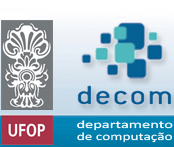

Qualificação de doutorado do discente Geovani Martins dia 19/08 as 10hs.Qualificação de doutorado do discente Geovani Martins dia 19/08 as 10hs. Título: Trypanosoma cruzi parasite detection based on motion analysis in optical microscopy videos. Motion is an essential characteristic in the life cycle of many flagellated protozoa; nevertheless, it remains a relatively unexplored aspect in computational tools to aid research and medical diagnosis of diseases. In this context, a parasite is of special interest for this work: the Trypanosoma cruzi (T. cruzi). In dye-free blood samples, T. cruzi's low contrast challenges morphology-based detection and can lead to errors in laboratory inspections, making its motion an important visual clue. Assuming this parasite's motion is a conspicuous visual stimulus for microscopists, we proposed three motion-based T. cruzi detection approaches: i) anomaly detection, ii) motion saliency, and iii) trajectory analysis. All experiments were conducted using datasets of trajectories and optical microscopy videos. Initially, we introduced a spatio-temporal autoencoder using the convolutional long short-term memory (ConvLSTM) technique for training and predicting anomaly motions caused by parasites. Compared to a state-of-the-art approach, our model outperformed it in some cases. Inspired by human visual attention mechanism, we suggested creating a step to evaluate motion saliency maps in the second approach, aiming to improve bottom-up saliency methods for T. cruzi detection. Preliminary results from a saliency-driven system model indicated a high incidence of false parasite vestiges that could be avoided. In the third approach, we analyzed the trajectory of T. cruzi and blood cells to discriminate between these elements by identifying the following motion patterns: collateral, fluctuating, and pan-tilt-zoom (PTZ). Since the parasites perform the collateral motion, their trajectory steps tend to randomness. The cells may assume fluctuating motion following a homogeneous and directional path or PTZ motion with trajectory steps in a restricted area. Thus, our findings contribute to developing new computational tools focused on motion, which can assist the research and medical diagnosis of Chagas disease. Data: 19 de agosto de 2024 Horário: 10hs. Local: Link da videochamada: https://meet.google.com/ide-mhcm-fra Banca: Profa. Dra. Andrea Gomes Campos Bianchi (UFOP), Prof. Dr. Daniel Silva Ferreira (IFCE); Profa. Dra. Fátima Nelsizeuma Sombra de Medeiros (UFC), Prof. Dr. Eduardo José da Silva Luz (UFOP) e Prof. Dr. Rafael Alves Bonfim de Queiroz (UFOP-Suplente). |
Departamento de Computação | ICEB | Universidade Federal de Ouro Preto
Campus Universitário Morro do Cruzeiro | CEP 35400-000 | Ouro Preto - MG, Brasil
Telefone: +55 31 3559-1692 | decom@ufop.edu.br